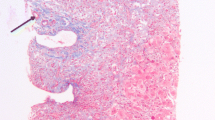Abstract
We describe a rare case of drug-induced hepatitis due to the smoking cessation agent varenicline in a 46-year-old Asian woman. The liver injury progressed in two steps. First, the liver injury started in the absence of viral/autoimmune responses, and withdrawal of varenicline lowered the increase in the levels of liver enzymes immediately. Such findings suggested varenicline-induced liver injury. Second, hepatitis recurred in association with conversion of antinuclear antibody from negative to positive about 8 weeks after the initial episode. Histology upon recurrence of liver injury revealed interface hepatitis with lymphocytic and lymphoplasmacytic portal inflammatory infiltrates extending into lobules. Such findings suggested autoimmune hepatitis. Corticosteroid treatment was effective for recurrent hepatitis. The clinical course suggests that varenicline caused drug-induced liver injury and subsequent autoimmune hepatitis. Some autoimmune changes were probably involved in the mechanism of varenicline-induced liver injury.


Similar content being viewed by others
References
Franck AJ, Sliter LR. Acute hepatic injury associated with varenicline in a patient with underlying liver disease. Ann Pharmacother. 2009;43:1539–43.
Sprague D, Bambha K. Drug-induced liver injury due to varenicline: a case report. BMC Gastroenterol. 2012;12:65.
Mogensen H, Björnsson ES. Varenicline-induced acute liver injury with jaundice. Hepatology. 2015;61:2110–1.
Fontana RJ, Seeff LB, Andrade RJ, et al. Standardization of nomenclature and causality assessment in drug-induced liver injury: summary of a clinical research workshop. Hepatology. 2010;52:730–42.
Stine JG, Northup PG. Autoimmune-like drug-induced liver injury: a review and update for the clinician. Exp Opin Drug Metab Toxicol. 2016;12:1–11.
Watanabe M, Shibuya A. Validity study of a new diagnostic scale for drug-induced liver injury in Japan-comparison with two previous scales. Hepatol Res. 2004;30:148–54.
Lohse AW, Hennes E. Diagnostic criteria for autoimmune hepatitis. Hepatol Res. 2007;37(Suppl 3):S509.
Murata Y, Ogawa Y, Saibara T, et al. Tamoxifen-induced non-alcoholic steatohepatitis in patients with breast cancer: determination of a suitable biopsy site for diagnosis. Oncol Rep. 2003;10:97–100.
Ahbeddou N, Belbaraka R, Fetohi M, et al. Tamoxifen-induced hepatotoxicity. Indian J Cancer. 2011;48:385.
Takikawa H, Takamori Y, Kumagi T, et al. Assessment of 287 Japanese cases of drug induced liver injury by the diagnostic scale of the International Consensus Meeting. Hepatol Res. 2003;27:192–5.
Alvarez F, Berg PA, Bianchi FB, et al. International Autoimmune Hepatitis Group Report: review of criteria for diagnosis of autoimmune hepatitis. J Hepatol. 1999;31:929–38.
Weiler-Normann C, Schramm C. Drug induced liver injury and its relationship to autoimmune hepatitis. J Hepatol. 2011;55:747–9.
Iwamura S, Kojima Y, Ohka R, et al. Nidome no kanseiken de syouyou chuusintai eshi wo mitome, yakuzai kiinsei jikomenekisei kanen to shindan sita ichirei (A case of drug-induced autoimmune hepatitis demonstrated initial findings of centrilobular necrosis at the second liver biopsy). Kouchi Sekijuuji byouin Igaku Zasshi (Med J Kouchi Redcross Hospital) [published in Japanese]. 2016;21:39–44.
Bebo BF, Dehghani B, Foster S, et al. Treatment with selective estrogen receptor modulators regulates myelin specific T-cells and suppresses experimental autoimmune encephalomyelitis. Glia. 2009;57:777–90.
Behfarjam F, Sanati MH, Nasseri Moghaddam S, et al. Role of Th1/Th2 cells and related cytokines in autoimmune hepatitis. Turk J Gastroenterol. 2017;28:110–4.
Author information
Authors and Affiliations
Corresponding author
Ethics declarations
Conflict of interest
Mitsuru Sakakibara, Kazuyoshi Ohkawa, Takatoshi Nawa, Yutaro Abe, Akira Kusakabe, Toshihiro Imai and Kazuhiro Katayama declare that they have no conflict of interest.
Human rights
All procedures followed have been performed in accordance with the ethical standards laid down in the 1964 Declaration of Helsinki and its later amendments.
Informed consent
Informed consent was obtained from all patients for being included in the study.
Rights and permissions
About this article
Cite this article
Sakakibara, M., Ohkawa, K., Nawa, T. et al. Two-step progression of varenicline-induced autoimmune hepatitis. Clin J Gastroenterol 11, 184–187 (2018). https://doi.org/10.1007/s12328-018-0824-x
Received:
Accepted:
Published:
Issue Date:
DOI: https://doi.org/10.1007/s12328-018-0824-x




